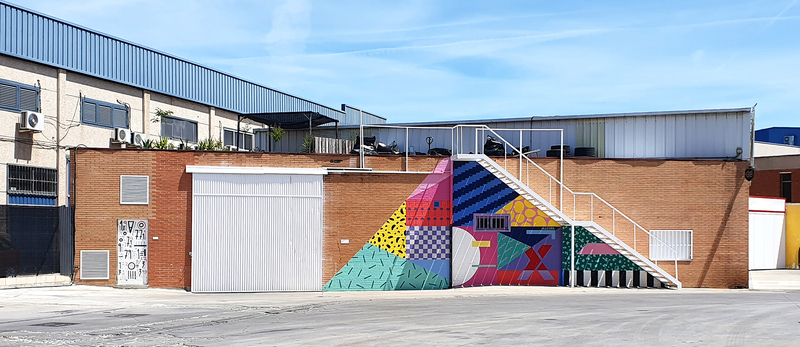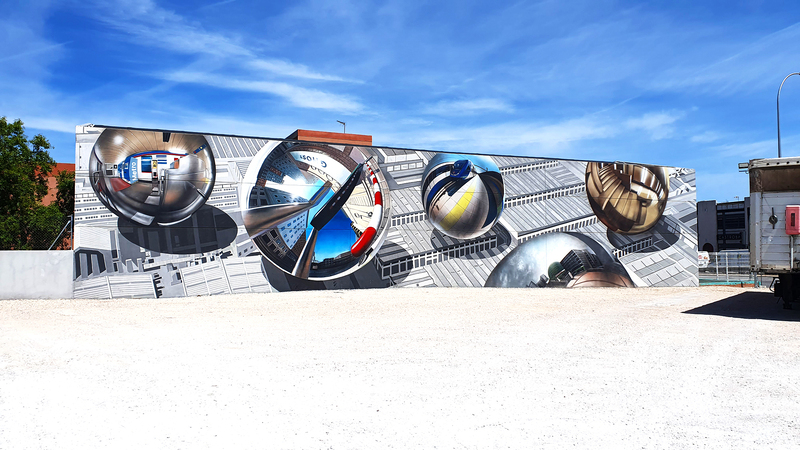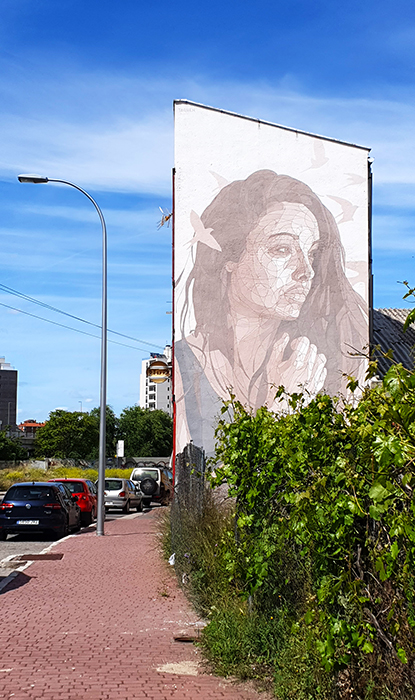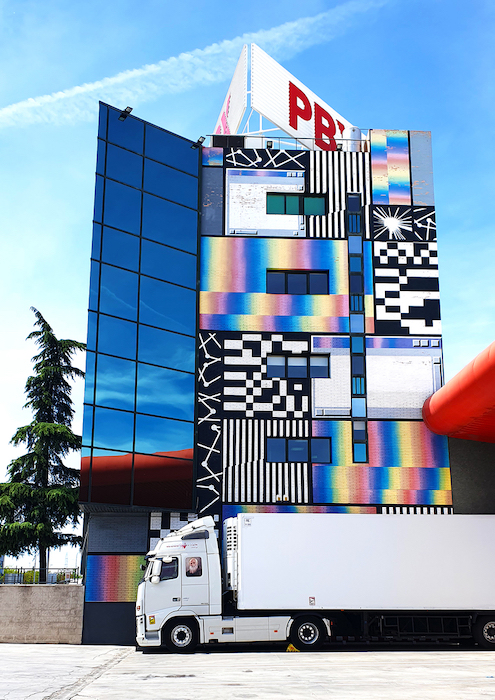Villaverde, once a separate municipality, was absorbed by Madrid in 1954, becoming one of the city’s 21 districts. From the 1950s to the 1980s, Villaverde thrived as an important industrial hub. Today, the district boasts a blend of residential areas, industrial zones, commercial spaces, and green areas.
In recent years, Villaverde has emerged as a center for urban art, with various murals and street art projects transforming its industrial landscape. This artistic revival is part of a broader effort to rejuvenate the district, making it more attractive to both residents and visitors.

Madrid Street Art Map

Urban Art in Madrid Villaverde Alto
Villaverde Alto‘s old quarter is characterized by quiet streets with names that reflect its rural past, a nod to the “verde” (Spanish for green) in its name. This area, which once housed workers from the nearby industrial zone, has retained its strong industrial heritage, with several factories and industrial sites that have historically contributed to its economy.
As we wandered through Villaverde Alto’s residential area, we encounter impressive murals created by some of Spain’s best urban artists:
One of my favorite murals in the area, and among my favorites in the whole city, is “Vintage Wall Paper” by Escif. This piece features a vintage wallpaper pattern the Valencia-based street artist found inside that very building, adorned with portraits of the people who live there.
Another stunning mural nearby is “Airllucinogen” by Liquen. It draws from the surrounding environment—a neighborhood facing social and human challenges, characterized by disparities, neglected areas, marginalization, and drugs. Liquen uses these issues to contemporize Goya’s famous painting “The Sleep of Reason Produces Monsters.” Like in Goya’s work, we see a man asleep at a desk, surrounded by fantastic and frightening creatures that symbolize the fears, contradictions, and brutalities of both the neighborhood and modern society in general.
Additionally, the neighborhood is graced with a sensitive mural by Sam3.

More recently, Taquen painted a female figure in his characteristic style of flowing lines that evoke movement. The mural, titled “A Look to Another (Better) Future,” addresses the trafficking of women and prostitution that afflicts the area. The girl gazes into a future of equality and respect, a future where women in Villaverde are not prostitutes but are welcomed into the professional environment they deserve. Her gaze is accompanied by a flock of swallows, birds that migrate to safer and less hostile places, symbols of hope and new beginnings.
Colección PBX Creativa
As part of the urban walks I organized for the readers of this blog, I arranged a visit to the headquarters of Palibex Logistica. This logistics company is led by CEO Jaime Colsa, an art lover, collector, and patron of the arts. Over the years, Colsa has sponsored various urban art projects, including the “Truck Art Project” (a mobile art collection where the trucks of his company serve as monumental canvases) and a series of large murals at the PBX premises in Villaverde Alto, Madrid.

I wanted to photograph these murals for the Madrid street art book I’m publishing later this year, and so we met with the lovely Carla, who gave us a tour of the impressive art collection adorning the external walls, offices, warehouse walls, and inner yard of the company.


Since 2014, street artists such as Suso33, Okuda San Miguel, Sixe Paredes, Rosh333, Antonio Fuente, Daniel Muñoz, Felipe Pantone, Antonyo Marest, JNK, and Ana Barriga have been invited to paint large surfaces of the Palibex HQs.
The result is an outstanding collection (dubbed PBX Creativa) that makes the workplace much more pleasant and stimulating for the employees.

One of my favorite interventions within the Palibex premises is a room by Suso33, who painted his iconic presencias all around the common area where workers eat and have coffee breaks.

Another cool intervention is by JNK, who wrote the names of each employee inside the elevator in graffiti tag style.
There are three massive murals visible from the street without entering the Palibex offices:

“Mo-Evolution” by Okuda San Miguel, created to raise awareness for Movember, an annual event promoting men’s health issues like prostate cancer, testicular cancer, and men’s mental health.

A piece by Daniel Muñoz (SAN) painted in 2017, reflecting on how we interact with images and the internet. It depicts a series of characters, transformed through various references to internet elements, like Facebook comments, 19th-century paintings, absurd YouTube searches, and more. These can be interpreted as self-advertisements, self-portraits, or a sort of daily punishment that shadows us.
“Ultra-Plasticism” by Felipe Pantone, also painted in 2017, features three distinct compositions, deconstructed, recomposed, and repeated across the workspace. The fragments showcase Pantone’s signature style, characterized by kinetic art elements, digital glitches, and acidic textures, creating a break or disruption in reality, a flaw in the everyday code.
More XXL Murals in Madrid Industrial Area
Next to the Palibex Logistica HQs, and thus often obscured by the company’s trucks (tip: visit in the morning!), there’s a mural promoted by the city council. Painted by Madrid graffiti pioneer Spok Brillor, this long artwork features Spok’s iconic spheres that create visual games reminiscent of Escher’s art universe.

Inspired by Palibex Logistica, several other industrial companies in the area have transformed the large walls of their warehouses and factories into canvases for art.

Among my favorite murals in the area are these two pieces by Virginia Bersabé and Iñigo Sesma:

Before this, I wasn’t familiar with Virginia Bersabé’s work, and discovering it opened the door to her mesmerizing artistic universe, filled with depictions of elderly women, rural atmospheres, and narrative-rich pieces.

Another remarkable artwork in the area is by Argentinian street artist Ever. His compositions may initially resemble classic still-life paintings, but a closer look reveals the unusual presence of everyday elements. These works are part of Ever’s investigation into empathy and the role of “capitalism’s objects” in it. He starts with the premise that every object has a function, but our empathy and projections onto these objects go beyond their practical uses.

Lastly, I loved the nuanced abstract mural by J.P. and Bernie, painted as part of a city project aimed at the revitalization of the Poligono Marconi area.

Madrid Street Art Map

Street Art in Madrid Villaverde Bajo
Home to a diverse population, including many migrant families, Villaverde Bajo neighborhood is primarily residential, featuring a mix of older apartment buildings and newer developments.
The area, characterized by its Neo-Mudéjar architecture, was once the industrial heart of southern Madrid, a legacy still visible in its former industrial buildings that have been majestically repurposed, such as La N@ve, a spectacular reinforced concrete structure that once served as the Boetticher y Navarro factory and now houses a center for inspiration, education, and open innovation.
Festival Circular in San Cristobal
San Cristobal, a neighborhood in Villaverde Bajo, has been hosting the Circular Festival since 2019, organized by Madrid Street Art Projectos. Circular is an art festival dedicated to creating artistic interventions in public spaces using recycled and found materials. Stepping away from the mural format, the festival seeks to return street art to a more human scale, rekindling its intimate, community-focused roots.

Many of the small-scale and often ephemeral interventions from the Circular Festival are no longer visible in San Cristobal, but a few artworks still stand proudly. As soon as we got off the bus, we stumbled upon one of the textual interventions by Anaïs Florin from 2023, which read, “Seguiremos haciendo ruido hasta que nos escuchen” (We will keep making noise until they listen to us).

Wandering through this multicultural area, I also spotted numerous tiny figures by Helen Bur, who continues her poetic project of portraying residents of different cities from behind. In San Cristobal, Helen depicted 20 people from the neighborhood, reflecting the diversity and life of San Cristobal.
As Villaverde continues to grow and transform, it stands as a testament to Madrid’s dynamic evolution from an industrial heartland to a hub of artistic innovation and community spirit.
I look forward to visiting again in the coming years, confident that I will discover many changes in the area—and perhaps new murals too!




